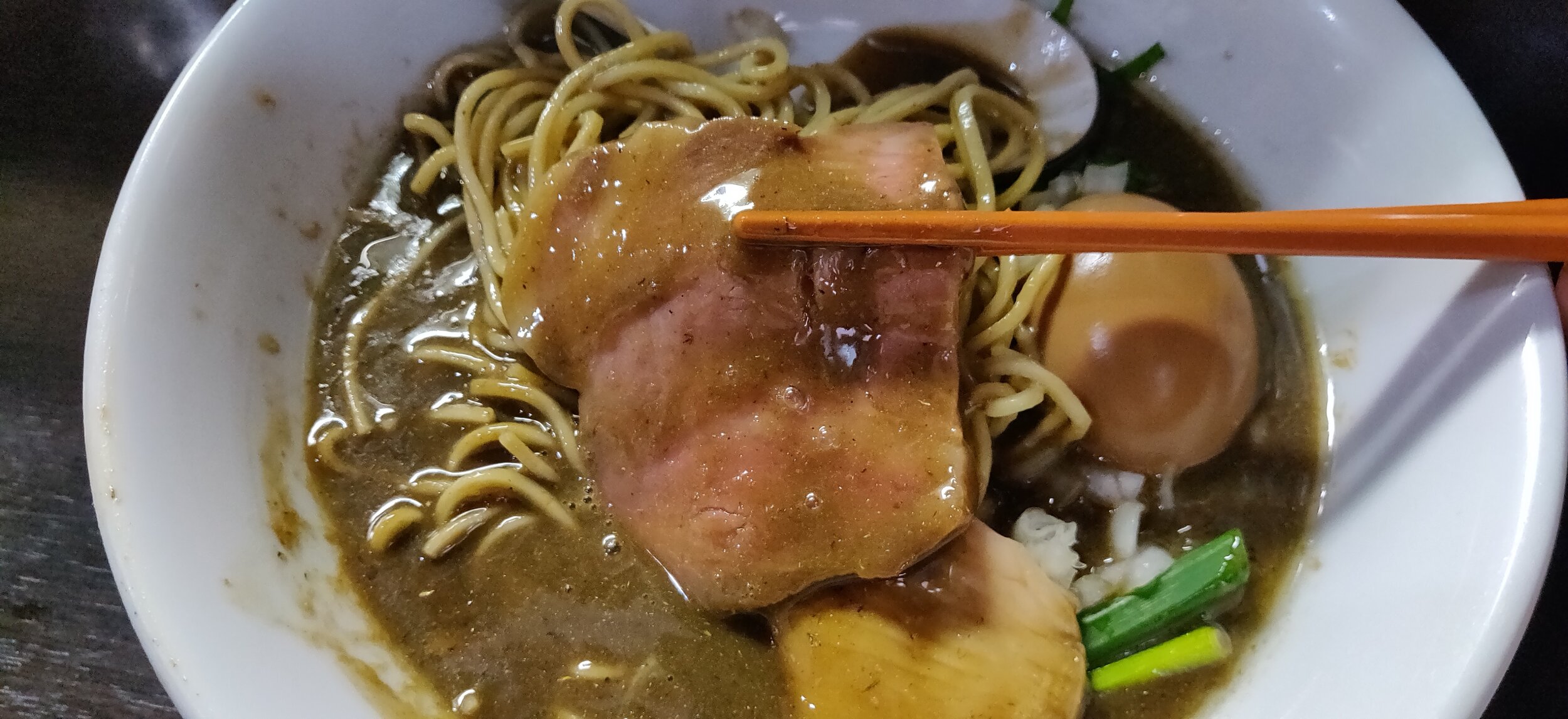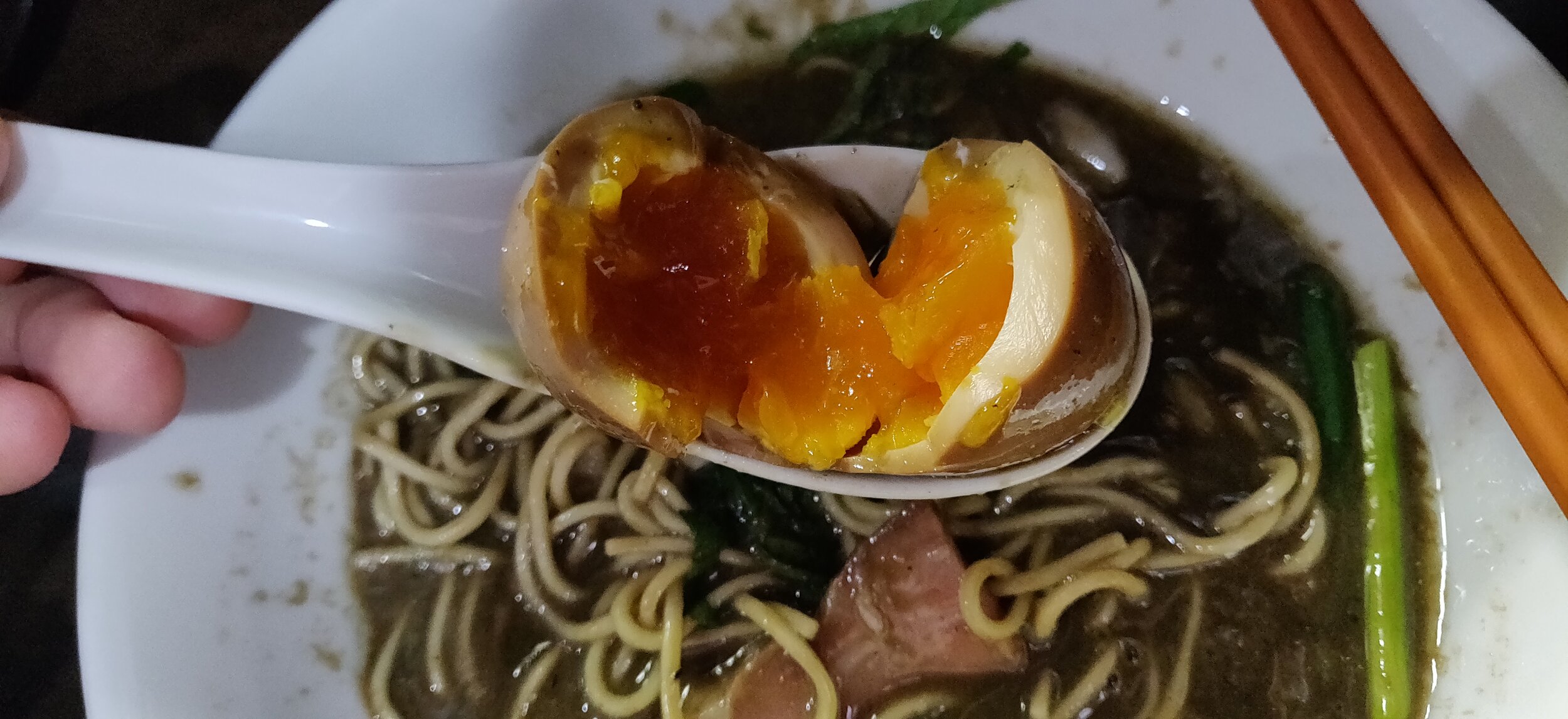Chuka Soba Izuru (中華そば いづる); Noukou Niboshi of Central Tokyo, Daimon, Tokyo
Probably comes as no surprise to my long time followers that one of my favorite ramen varieties is the thick, cement grey gold that is Niboshi ramen. While it may not cater to the taste buds of everyone, I love the sodium enriched bitterness the Niboshi gives off in this one of a kind ramen style. My favorite is definitely Chuka Soba Ibuki with Hiwamatanoboru coming in at a close second, but these two shops are far from central Tokyo and is one that I have to plan my day around to have. However, I found that this shop, Chuka Soba Izuru, gets pretty close to the flavors from my favorite two shops and is easily accessible so when my cravings arise, I head here to get my fill. Fair warning though, it is a pretty intense flavor profile and one that I can’t recommend to too many people. If you’re not a huge fan of fish, or would like a more lighter airy broth, this is not the restaurant for you. For those more adventurous ramen eaters, I recommend a visit here before heading to Ibuki or Hiwamatanoboru to get a sneak peek of this ramen style without making a long trek. Izuru is open Monday through Friday from 11:30-14:00 for lunch and 18:00-20:00 for dinner with the exception of Friday which open from 19:00-21:00.
Hours are pretty typical of what ramen shops are like in central Tokyo, near most of the office buildings, as most of their clientele comes from office workers nearby stopping for lunch or after work for dinner. As the nearby area is quite empty on weekends, Izuru decided not to open on weekends. Lines can get quite long as it is a popular spot among workers nearby, as well as ramen enthusiasts, so I recommend coming early to grab a bowl. As you can tell from the ticket machine, they don’t get a lot of foreign customers so the menu is all in Japanese so I did my best to translate them here. Starting with the top row, the two buttons are for their regular Niboshi Soba and the Niboshi Soba with a soft boiled egg. The button to the far right is for a specialty menu which I’ve never seen offered in my times I’ve visited here, but I would assume it would be advertised out front. Second row is the Noukou Niboshi Soba and Noukou Niboshi Soba with soft boiled egg. On the far right side is the tsukemen version and again comes as is and with a soft boiled egg. Third row is the side menu starting with extra noodles, then rice, fish roe and bait fish over rice, and a marinated sashimi over rice. Fourth row are the toppings which include Ajitama soft boiled egg, Tamanegi diced raw onions, Iwanori dehydrated seaweed, and Char Siu Mashi extra pork char siu. The last row is for a small and medium beer. Menu is quite simple and they really take pride in their Niboshi soup base. For first timers, I definitely recommend the regular Niboshi Soba, but if you’re keen, try their Noukou version on the second row which is a condensed, richer version of their regular ramen. I opted for the thick version and, even for me, it was a bit much. I’ll let you decide which is best for you, but again, for first timers, I definitely recommend sticking to the regular Niboshi ramen.
So pictured here was my order of the Noukou Niboshi Soba with a soft boiled egg. Presentation here is absolutely gorgeous with the clean white porcelain bowl acting as a backdrop to the dark hue of the Niboshi soup and crisp colors of the toppings. My bowl was adorned with a slice of pork char siu, chicken char siu, green onions, Japanese shisho leaves, raw diced onions, a naruto fish cake and my extra topping of marinated soft boiled egg. I get this question often where people will ask, “Where is my naruto fish cake?” I’ve seen a trend nowadays in that higher end ramen shop will skip the fish cake unless the soup also includes fish. Here, as its’ a Niboshi fish broth, a slice of naruto fish cake comes along as a topping. If you don't see one, it might just be that the chef didn't think it would mesh with their bowl.
Anyways, back to this bowl. Soup here is the main attraction and to be honest, everything else in the bowl only serves to compliment and help make the soup better. As I’ve already mentioned countless times, the soup is Niboshi, or dried sardines, and in the incredibly rich variety. When I say it looks like cement, I’m being completely honest as the grittiness of the Niboshi gives the broth speckles that mirror that of a cement block. Taking your first sip, you’ll immediately be drawn to the powerful bitterness of the Niboshi, but then mellowed out by the soy sauce seasoning tare. It’s not exactly the richness that gets to you, but the thickness of the broth entangled in the bitter Niboshi bits. This is where the noodles play a big part of your enjoyment of the dish. Noodles are similar to what you find in a Hakata style tonkotsu ramen joint and the idea behind it is essentially the same. The thin noodles have a very specific kansui level which allows it to soak up just enough of the soup where you’re not overpowered by the niboshi flavor, but is thin enough that its’ not being coated with too much of the soup either. The balance of the two is really the chef’s dedication in finding the right noodle recipe for his unique ramen broth and is something that has to be applauded as I imagine it took countless trials and errors.
Next up are the toppings which, again, are added to make your bowl of ramen more enjoyable. Both chicken and pork char siu slices are seasoned lightly and cut a tad thick in order to balance with the rich flavors while not adding an extra saltiness to the bowl. The pork is cooked rosy pink and this is due to it being cooked in an immersion cooker, or sous vide, so it never faces direct heat. The sous vide cooking style has become quite popular among top ramen restaurants so you’ll see this rosy pink hue often, but don’t let it scare you. Pork is cooked to proper temp and you won’t deal with any illnesses stemming from under cooked proteins in these high end ramen shops. Green onions and raw diced onions are a must for this soup as it is quite strong and the freshness as well the the acidity of raw onions help cut through the density of the broth. If you did end up getting the thicker Noukou Niboshi soba here, I’d recommend getting extra raw onions toppings. Not only does it help cut through the thick soup, the pairing is oddly amazing and gives you a unique flavor profile I can’t quite explain. The only thing I can compare it to is the thinly sliced onions you’ll be served at fish izakayas in Tokyo along side sashimi and katsuo no tataki, or grilled bonito. The onions help eliminate any unwanted odors of the fish and changes the flavor structure to a clean, umami enriched bite. The unique topping here is the Japanese shiso leaves which is kind of like a Japanese mint. It doesn’t have a strong spearmint flavor, but it has a similar herbiness that is very unique to Japanese cuisine. I was a bit taken aback with the inclusion of the Shiso, as I rarely see it in ramen, but it definitely works with the bowl. The Shiso’s distinct herb-y flavor almost cleanses your taste palette and softens the blow of the bitter Niboshi. Finally the soft boiled egg was a definite must as the creaminess of the yolk helps to mellow out the flavors of the soup. At the table you can include some vinegar as well which helps cut through the rich creaminess of the soup and lighten it up a bit.
So once you’re seated, you’ll see a sign for something called an aedama. The aedama is something unique to Niboshi style ramen and I’ve yet to encounter it with other varieties. It’s essentially extra noodles, but is pre-seasoned with some sauce so you can enjoy it as is before throwing in to your bowl. The kaedama, which you may have seen offered at the ticket machine here, is what you might be familiar with as its served quite often in Hakata style, tonkotsu ramen shops. Typically it’s just the noodles which you drop in directly to your bowl; no toppings, no sauce, just plain noodles. The aedama, as you can see from the photo, comes adorned with some sauce at the bottom as well as a mixture of toppings that the chef think will pair with the noodles and sauce. Here it was topped with diced pork char siu, a sprinkle of raw diced onions, and some gyofun. Gyofun directly translated is fish powder and this here is the ground up niboshi that they also use for the broth. Sauce is a bit of their soy sauce seasoning tare and the noodles are dry as is, so once you receive your aedama, mix the sauce at the bottom thoroughly so that each strand is properly coated. Take some noodles as is and you’ll get a great flavor of how the seasoning tare tastes without the overwhelming flavors of the niboshi broth. You’ll get a sweetness to it, almost like a teriyaki sauce, and you’ll see how it helps both accentuate the umami flavors of the broth, but also dampen the bitterness of the niboshi. The gyofun is a nice touch to help remind the palette of its core as a niboshi ramen shop. Once you’ve tasted it as is, add some of the vinegar in there to give it a second layer of flavor. The acidity will break apart some of the fats of the seasoning tare and mellow out the noodles while giving it a familiar tang. Add a bit more before throwing it in to your soup and the combination of the onions and vinegar really changes up the flavors of the soup. I won’t spoil it for you here, you’ll just have to try it for yourself, but this combination of Niboshi with onions and vinegar is what I live for with these bowls and is what turns the bitter niboshi in to a sweet, succulent, complete ramen bowl.
Well if you’ve made it this far and you’re still convinced that you want to try a bowl of this memorable ramen style, I definitely recommend a visit to Izuru. If you end up liking it, make the trek up to Ibuki and Hiwamatanoboru and I guarantee you’ll be addicted. The ramen is unlike any other you’ll ever have in non-niboshi styles and it becomes a dirty habit you can’t drop. What you initially thought is too bitter becomes a lingering memory that makes you wanting more. I used the bitter term way too much, but unless you try it yourself, its really hard to grasp what the bowl fully has to offer. If you do make it out, be sure to let me know what you thought in the comment section below or through my social media sites @ramenguidejapan on instagram, Ramen Guide Japan on facebook, or @guide_ramen on twitter.







